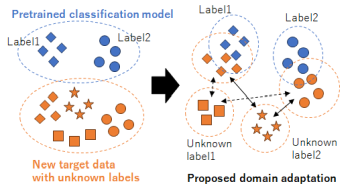
Domain adaptation, which transfers an existing system with teacher labels (source domain) to another system without teacher labels (target domain), has garnered significant interest to reduce human annotations and build AI models efficiently. Open set domain adaptation considers unknown labels in the target domain that were not present in the source domain. Conventional methods treat unknown labels as a single entity, but this assumption may not hold true in real-world scenarios. To address this challenge, we propose open set domain adaptation for image classification with multiple unknown labels. Assuming that there exists a discrepancy in the feature space between the known labels in the source domain and the unknown labels in the target domain based on their type, we can leverage clustering to classify the types of unknown labels by considering the pixel-wise feature distances between samples in the target domain and the known labels in the source domain. This enables us to assign pseudo-labels to target samples based on the classification results obtained through unsupervised clustering with an unknown number of clusters. Experimental results show that the accuracy of domain adaptation is improved by re-training using these pseudo-labels in a closed set domain adaptation setting.

Virtual Adversarial Training has recently seen a lot of success in semi-supervised learning, as well as unsupervised Domain Adaptation. However, so far it has been used on input samples in the pixel space, whereas we propose to apply it directly to feature vectors. We also discuss the unstable behaviour of entropy minimization and Decision-Boundary Iterative Refinement Training With a Teacher in Domain Adaptation, and suggest substitutes that achieve similar behaviour. By adding the aforementioned techniques to the state of the art model TA3N, we either maintain competitive results or outperform prior art in multiple unsupervised video Domain Adaptation tasks.

The number and availability of stegonographic embedding algorithms continues to grow. Many traditional blind steganalysis frameworks require training examples from every embedding algorithm, but collecting, storing and processing representative examples of each algorithm can quickly become untenable. Our motivation for this paper is to create a straight-forward, nondata-intensive framework for blind steganalysis that only requires examples of cover images and a single embedding algorithm for training. Our blind steganalysis framework addresses the case of algorithm mismatch, where a classifier is trained on one algorithm and tested on another, with four spatial embedding algorithms: LSB matching, MiPOD, S-UNIWARD and WOW. We use RAW image data from the BOSSbase database and and data collected from six iPhone devices. Ensemble Classifiers with Spatial Rich Model features are trained on a single embedding algorithm and tested on each of the four algorithms. Classifiers trained on MiPOD, S-UNIWARD and WOW data achieve decent error rates when testing on all four algorithms. Most notably, an Ensemble Classifier with an adjusted decision threshold trained on LSB matching data achieves decent detection results on MiPOD, S-UNIWARD and WOW data.

A scenario of domain adaptation (DA) in machine learning occurs when training and test data are drawn from some population with different distributions. In steganalysis, this scenario can arise when images used for training and testing come from different cameras, especially in blind detection. Although there has been some work in this area, it is still not clear that one can design a feasible detection scheme for all devices from one camera model. In this research, Spatial Rich Models (SRM) and ensemble classifiers have been applied for feature extraction and classification, respectively. After carefully collecting images from several camera models from mobile phones, with at least two devices for each model, we identify two measurable factors that affect detection: ISO speed and exposure time. This allows us to adapt the classifier from one device to a different one of the same model, even when images from the two devices are significantly different in visual appearance, by choosing specific training data. Our experiments show that a well-trained stego detector based on data from one source shows more adaptability to new target data if the training images have similar distributions of ISO speed and exposure time as the target images.